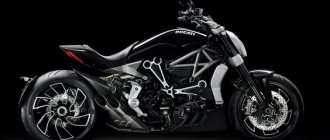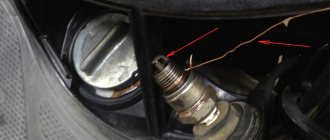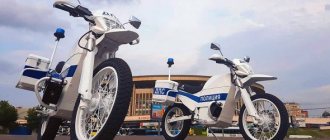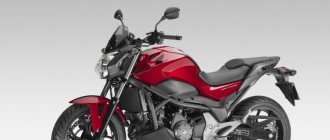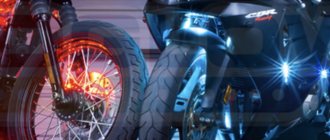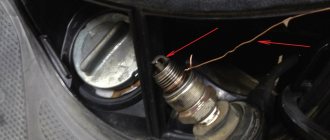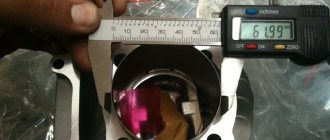The last warm days are coming to an end and it’s time to think about storing your motorcycle for the winter. Unfortunately, motorized vehicles, unlike four-wheeled vehicles, are not suitable for traveling on icy and snowy roads. Many insufficiently responsible motorcyclists without any hesitation leave their horse to spend the winter in a parking lot or in an unheated garage without prior preparation. It is worth understanding that this approach is fundamentally wrong. At low temperatures and changes, the bike's systems deteriorate and subsequently the service life of the vehicle will be much shorter.
This article is dedicated to responsible owners who are ready to approach the wintering of their iron friend with great care. Considering that most garages still do not have heating, we will talk about preserving the motorcycle for the winter and storing it in an unheated garage. Below you will find answers to the following questions:
- How to preserve a motorcycle for the winter?
- What details should you pay attention to?
1). General preparation of a motorcycle for winter
A motorcycle, like any other equipment made of metal, really does not like dirt. To prevent the paintwork from fading and premature oxidation of metal surfaces, that is, rusting, it is necessary to wash the motorcycle clean before long winter storage, let it dry, then wipe it dry and treat it with polish.
Ten (10) Strangest Motorcycles Ever Built
It is necessary to wash the motorbike with warm water with the addition of a special cleaning agent that removes dirt, oil and grease. At the same time, it does not damage the paintwork of the equipment. There are many similar car and motorcycle wash products on the Internet that are suitable for your car or motorcycle.
Please note that it is advisable to wash the equipment directly at the place of its future storage, otherwise your work may be in vain, because dirt can still get on the paint during transportation, and it can ultimately lead to a source of corrosion.
After washing, the motorcycle must be treated with polish. This way you will create an artificial moisture barrier. Finally, treat any exposed metal surfaces with WD-40 to dislodge any remaining water and make them more resistant to corrosion.
Attention to detail
Not all motorcycle preservation measures are interpreted unambiguously. There are so many controversies and opinions around the oil change alone that it would be enough for a scientific study. Therefore, we want to talk a little more about the most important or controversial points in motorcycle conservation.
Oil
The main subject of debate is the following: change the oil before or after wintering. And there is no definite solution, but there is only one recommendation - it is better to change it twice. But it is clear that most motorcyclists do not want to spend money on another container of oil and end up changing one thing only once.
But we would still recommend a compromise option - fill in cheaper oil for the winter. Best from the same manufacturer. For example, expensive semi-synthetic oils can be safely replaced with oils from the same manufacturer, but with fewer additives. Please note that you should not mix completely different oils (for example, if you used synthetic oil, it cannot be replaced with mineral oil). Nothing bad will happen, of course, but when mixing fundamentally different oils, chemical reactions can begin, which will result in the formation of solid compounds that will subsequently scratch the cylinders rather than lubricate them.
If you decide that two oil changes are too expensive or simply not necessary, then it is better to change it at the end of the season. During downtime, the new oil will not deteriorate (usually the shelf life is a year after opening), which means it will be good in the spring and the entire next season.
Tank
To protect the gas tank from corrosion during non-use, it is recommended to fill it with gasoline to capacity. This will help prevent air and water from entering. Another solution is to completely remove, wash and dry the gas tank. But this method is good if your plans include going through the entire motorcycle over the winter. If you are going to can it, then there is little point in doing so.
To make it easier to start a bike engine in the spring, you can add a specialized fuel stabilizer to gasoline. It is an additive that prevents fuel separation and breakdown. Considering that, under ideal conditions, gasoline is stored for about a year, and in an unheated garage, delamination will begin within a few months, the use of a stabilizer is quite justified. After all, we need to maintain the quality of gasoline for 4-5 months.
Battery
To shoot or not to shoot? In fact, you can do whatever is convenient, but the safest thing to do is remove it, charge it and leave it in a warm room until spring. It is advisable to check the charge level from time to time, since there are often batteries that have a high self-discharge current and need to be recharged periodically. In the spring, before your first trip, be sure to fully charge the battery.
If you decide to leave the battery in the garage, you should take the following steps:
- Treat contacts with anti-corrosion spray.
- During the winter, come and start the engine so that the battery is charged. The probability that without these manipulations it will go to zero is close to 100%, and after a complete discharge the quality of its work may deteriorate significantly.
Candles
It is better to unscrew the spark plugs for the winter. If they are old, then don’t hesitate to replace them. If they are still good, then throughout the winter you should have time to clean them and check the gaps. After pouring oil into the holes for the spark plugs, you can either plug them with a rag or return the spark plugs to their place.
Provided that the candles were stored separately, they should be treated with high-temperature copper paste before the start of the season. This will help prevent the thread from souring and the spark plugs will be easy to unscrew.
Video:
Preserving a motorcycle for the winter in a cold garage is a responsible undertaking that requires the owner of a motorcycle to make some financial investments, work and patience. But the benefits of this procedure for the bike are difficult to overestimate. All systems in a mothballed motorcycle after wintering remain in the same condition as before it. If the conservation was carried out correctly, then in the spring you will be able to start your iron horse from the first turn. Therefore, it is highly recommended to take care of your vehicle and thoroughly prepare it for winter, especially if it is going to spend about 4 months in a cold garage.
2). Changing oil and filters
Changing the oil and filters is extremely important for the lubrication system. It is much better to have fresh oil and new filters in it if the motorcycle will not be used for several months. By replacing new oil, you will prevent system blockages and dangerous oxides, cleanse the entire system of unnecessary toxins with this oil and increase the protection of the engine itself. It is advisable to change the oil in the fall for one more reason, but for this reason, would you want to change the oil at the very beginning of the season, when your hands are already itching to start your motorcycle and ride faster? You probably won't want to? That's it!
Materials and tools you will need to preserve your bike
Preparing for parking may require some troubleshooting, so keep a tool kit handy. You will need: a cover, cleaners, chain lubricant (if the motor is a chain), a pump (compressor), a pressure gauge, napkins and microfiber, “cosmetics”, possibly oil and gasoline for topping up.
As for technical means, for installation indoors it is recommended to acquire a motorized tackle and blocking brackets. When rolling, the bike will be protected from falling, the load on the tires will be less, especially if there is no central stand, but only a side one.
4). Prepare the fuel system
Fill the tank with gasoline until the tank is full so that there is almost no air in it, as condensation may appear there and the tank will gradually begin to rust. Add fuel stabilizer to gasoline. Before the new season, it is better to drain this “old” gasoline and refuel with new one.
Washing and cleaning
The motorcycle must be perfectly clean before storing it in the garage. You can’t be lazy; wash the vehicle yourself. The cleaning company employees are not interested in cleaning it completely. They will make their work acceptable, not perfect. Particular attention should be paid to chrome elements and spokes. They are most often exposed to the negative effects of bitumen stains.
After washing, the motorcycle must be thoroughly dried. Ideally, use a compressor, but if the weather is dry, then you can “ride with the breeze.”
6). Preserve your tires for the winter
Tire storage is another important point in our tips. If you leave the motorcycle on a stand and it stands for a long time in the same place, then the tires themselves will be pressed through at the point of contact with the surface on which the motorcycle was standing. To prevent this from happening, there are two options. First, you need to buy special stands for the front and rear wheels. The second, preferable option, is to remove the wheels and take them home, and then store them at home, but only in a lying position. At the same time, the motorcycle itself without wheels must be placed in such a way that its suspension is not completely unloaded and the fork legs do not come completely out of the pants. This will prevent possible suspension problems in the future.
Why you shouldn’t neglect winter preservation
Because we all want to ride in the spring, and not repair and repaint our “wheels”. The worse the bike is protected from water (snow or condensation), dirt, direct contact with ice and low temperatures, the worse it will look in the spring, and the more consumables it will require to replace.
By leaving a bike on the street without preparation and without supervision during the winter, you run the risk of “getting” the capital or being left without “wheels” altogether, and in the spring, a normally preserved motorcycle is enough to wash, pump up the wheels and refuel.
7). Check antifreeze
If you will be storing your motorcycle in a place where temperatures may drop below zero, be sure to check the antifreeze level in the cooling system. It is very important! If you fill it with water, you may find a cracked cylinder block when you come to pick up your bike in the spring!
Availability of gasoline in the gas tank
The metal gas tank must be filled up to the neck for the winter. This is done to prevent corrosion on the walls of the vessel. It can clog carbs and jets, which will negatively affect the technical condition of the motorcycle. It is also recommended to add a special stabilizer that will prevent the fuel from breaking down into fractions. But if “92nd” gasoline is used, then this is not necessary.
The plastic gas tank does not need to be filled in for the winter, as it does not corrode. For this reason, they are becoming increasingly popular among motorcycle manufacturers.
8). Don't let small animals ruin your motorcycle
Small rodents and other animals, as you and I know, love secluded corners. It is not uncommon for them to sneak into exhaust pipes or build houses out of air filters. Stop them from doing this! Place the plugs on the most critical areas of the motorcycle, namely the exhaust pipes and air intakes. It is important that these plugs (this can be a thick piece of cellophane or a rag) are of bright colors, so that when you come in the spring to prepare the bike for departure and try to start it, you forgot to take them off.
Preserving the engine for the winter
A separate point worth highlighting is the question of how to preserve the engine for the winter . I don’t think it’s worth explaining why in a separate paragraph: the engine is the most important component of a scooter.
As you have already noticed in this publication, we provide information on the ideal preservation of a scooter for the winter. Such preparation of a moped for winter requires physical, material, and some moral costs (however, as with any maintenance, repair or tuning of a moped). But the result will not be long in coming in the spring :).
Preserving the engine for the winter begins by treating the crankshaft journals with a special aerosol lubricant. This will prevent the engine shaft from seizing due to rust on the journals.
If there is carbon deposits on the piston and valves, then you should disassemble the CPG and clean these elements. Also, when preparing the engine for winter, it is recommended to add a fuel system cleaner to the fuel, as well as purchase and apply a carbon remover and drive approximately 50 km. Removing carbon deposits should be taken seriously, as its parts can lead to mechanical damage to the cylinder-piston group.
To properly preserve the engine, it is recommended to replace the engine oil with new one. Under no circumstances should the engine crankcase be left empty (corrosion is a risk).
To protect the internal surfaces of the CPG from corrosion, special aerosols must be used. For 4t engines, this aerosol is launched through the spark plug hole, and then the crankshaft is cranked with a kick starter or starter for 5-10 s. For 2t scooters, the spray is first sprayed directly into the carburetor of a running engine for 15-20 s. Then the engine is turned off and the product is launched through the spark plug hole in the same way as with four-stroke engines. Instead of an aerosol, you can pour 3-5 cubic meters into the candle hole with a syringe. see engine oil and crank the starter a couple of times. This way we will lubricate the walls of the cylinder and piston.
10). Choosing storage space
A heated garage is best suited for storing such equipment (motorcycles). It is desirable that the temperature in it be uniform, around 10 -15 C. There should be no changes, much less sudden ones, in the bike storage room. They cause moisture to appear on the surface of the motorcycle, which can ultimately lead to rust.
Some bikers who do not have a garage store their motorcycles right at home. It is better not to resort to such extreme storage methods. Still, from the point of view of fire safety, storing a motorcycle in the house is not the best option, you never know what can be dropped on it, and lubricant or fuel flares up, as you know, instantly. Moreover, the motorcycle itself, even a motocross thing, is quite cumbersome, and do not doubt that it will definitely get in the way of the household.
Conservation for the lazy (mandatory minimum): procedure
If the bike is in good working order and just needs to be covered until spring, a minimum of operations will be enough. They need to be done in the given order: go and fill it up, wash it clean, dry it well, protect it.
Refueling
An incomplete metal gas tank in the cold will inevitably collect condensation inside itself, which will slowly turn its walls into rusty “flakes”. As long as the inner surface of the tank is free of visible corrosion, the process will proceed more slowly. When the tank is already uniformly red from the inside, it’s faster. Also, the larger the evaporation area, the faster gasoline will lose light fractions, reducing its octane number.
What to do to prevent this:
- Drain the gasoline and dry the tank thoroughly. Store it with the neck tightly closed - it will help if it is very rusty.
- Fill until full, draining the residue from the carburetor (if the power system is not injection) - the best option, but not for a living room.
- Leaving as much as you have inside, simply sealing the neck, is not a recommended option: gasoline is toxic and a fire hazard. But, subject to safety precautions, it can be used even in an apartment (the smell of gasoline disappears after a week).
If the motorcycle is stored in the cold (outdoors, indoor parking, in a garage without heating), you must fill the gas tank to the top.
The plastic tank does not require special manipulations. Just remember to close the faucet.
Washing and drying
Proper winterization of your motorcycle includes washing it more thoroughly than usual.
Important points:
- It is advisable to wash only at above-zero temperatures, or to arrange for thorough forced drying.
- Do not forcefully clean the paintwork, and do not wash or dry your motorcycle with old clothing, rags with buttons or rivets.
- In hard-to-reach places, a long-bristled brush will help.
- Keep a very dirty motorcycle under foam (shampoo) for a longer time; if possible, soap it twice.
- For stubborn stains, use bitumen stain cleaner or carb cleaner.
- In addition to external drying, you must warm up the engine by letting it run at medium (not idle) speed for 5 minutes.
- Do not wash the chain, brakes, exposed parts of electrical equipment and the throttle assembly with high-pressure washers!
Care for the seat according to the material. Leather - do not wash with plenty of water, it is better to remove dirt with wet wipes, and then treat with car interior conditioner.
If the seat gets very wet, remove it and dry it at home, warm. But not near the heater - so as not to warp it.
Tire pressure
Even when idle, the wheels slowly deflate, so if the motorcycle is stored on a side stand, it is necessary to inflate the tires 1–1.5 atmospheres above the operating pressure. If the bike will be standing on a trolley or stand, with the wheels hanging out, lower them by 0.5 atmospheres. If you plan to periodically come and roll the bike so that the rubber does not deform, do not change the inflation.
Battery
Any battery for motorcycles, no matter whether it is acid, gel, or AGM, requires storage at above-zero temperatures. It must be taken from a cold box or from the street into a warm room, fully charged and placed in a dry place where neither children nor pets can reach it. Preventatively check the charge every 1–2 months; if it drops below 11.5 volts, charge it.
Simply leaving the battery on the motorcycle with the negative terminal removed (if it is kept warm) is possible, but batteries, regardless of type and brand, are prone to self-discharge after a certain time. An older, more sulfated battery with a less dense electrolyte will discharge faster, within a couple of weeks. Relatively new - will last two to three months. But “it will last” is conditional. The battery is considered “live” if its charge has not dropped below 10.5 volts. Anything below is a deep discharge. If the voltage drops to 8.5 volts - not every battery from such a discharge will be restored - you will have to buy a new one.
Protection of paintwork, chrome, rubber
Painted, plastic, metal chrome parts and even motorcycle optics can be coated with any regular car wax (liquid polish for manual application or spray).
Rubber can be:
- Blacken (with blackening compound).
- Spray with silicone spray.
- Cover with foam that prevents drying out.
Any of these products can only be applied to the beads of tires. The working (central) part is not covered with anything - otherwise, until the top (impregnated) layer of rubber is erased, there will be no normal brakes.
Rodent repellent
Small pests happily gnaw on plastic and motorcycle wiring that is inedible for us. They can devour the casing of wires, gut the seat, making a nest out of it, gnaw off silicone grips and generally anything else they deem necessary.
The poisoned bait must be placed not on the mote itself, but not far from it. Better - on the floor, about a meter away. A special repellent spray - on the contrary, must be applied directly to plastic parts, handles, footrests and wire braiding.
Protective case
For long-term storage, you cannot use windproof fabrics or plastic film, so use a special motorcycle cover of the appropriate size and cut. In the HYPERLOOK catalog you can choose suitable enduro covers, “wrappers” for sports tourists, tourers and classics of different sizes.
When leaving the bike outside, do not wrap it completely - always make a hole at the bottom for ventilation. Indoors - do not tie the cover, but simply throw it over it, to protect it from dust.
Engine and gearbox oil
When preparing your motorcycle for winter, look at the manual and service book - if the oil needs to be changed in the next 300–500 km, it is better to do this before storing it. If maintenance is still a long way off, or winter repairs are planned, don’t change it. The internal combustion engine and transmission need to be serviced according to the regulations, the rest is unnecessary expenses.
Brake fluid and antifreeze
When a cold “hibernation” is planned outdoors or indoors, where the temperature drops to a serious minus, it is advisable to replace the old antifreeze with a new, denser one before preservation. Especially if it was replaced quite a long time ago and the next deadline is approaching.
Brake fluid is more hygroscopic than gasoline, so during cold weather it can “pick up” water. The tank needs to be filled under the cap, just like a gas tank. In the spring, be sure to remove the excess with a syringe. There is no need to change the brake fluid in the fall. It is better to do this before the spring departure.
Protective case
Its presence is not required.
If the garage does not have a high-quality ventilation system, then, on the contrary, the cover can cause harm. The resulting condensate will not be able to evaporate, and it will accumulate under the canvas. This will cause rust to form. If there is high humidity in the room, then you cannot cover the motorcycle with a cover. To summarize, all of the above tips are general in nature. Once again I would like to repeat that each vehicle is unique. Therefore, you should familiarize yourself with the official recommendations from the manufacturer. They can often be found directly on the company's main website.
Or you can use the professional storage service for motorcycles for the winter. Our company MOTOSAVE invites you to park your motorcycle in an equipped parking lot. We will independently prepare the equipment for wintering, taking into account all the above recommendations. Our company works under a contract and guarantees the safety of your vehicle.
The need to put your motorcycles in winter storage. How to properly prepare a motorcycle for winter?
Filling into cylinders
In order to prevent oxidation, it is necessary to unscrew the spark plugs and drop a few drops of engine oil directly into the cylinders. It is recommended to do this for the gas tank as well. This rule applies to all motorcycle storage conditions, even dry and warm rooms.
Protection of the body and paintwork
The motorcycle must be clean before storage. This is necessary to preserve the paintwork and prevent its destruction due to dirt. Next, it is recommended to cover the surface of the motorcycle with liquid polish or silicone grease. They form a dense protective film that will protect the paintwork from the negative effects of moisture.

